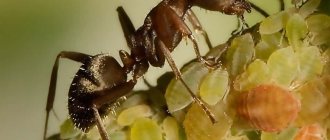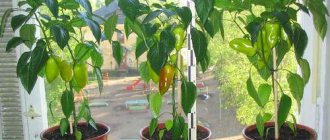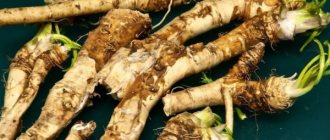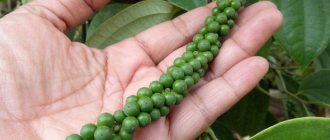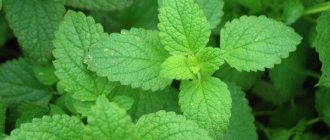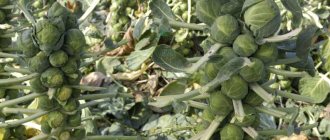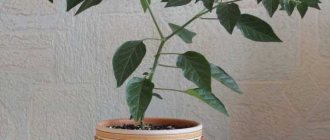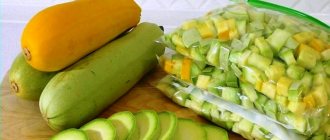Growing seedlings is not only about caring for the seedlings: regular watering, fertilizing and picking.
Sometimes you have to deal with insect pests and fungal diseases. Aphids are considered one of the most important enemies of pepper seedlings. Dear readers!
For you, we have created communities on social networks in which useful articles and interesting ideas are published several times a day! Subscribe and receive useful content in a convenient format! This time we will talk about where this pest comes from, how to fight it using store-bought medications and folk remedies, and what needs to be done to prevent the spread of the insect.
What does the pest look like and why might it appear?
Aphids are microscopic (up to 0.4 mm) insects of dark or light green color. At high magnification, it is noticeable that the aphid is teardrop-shaped and has a proboscis. With the help of this proboscis, she sucks out the juices of the plant, making a puncture in the tissues.
The main danger of aphids is their rapid reproduction and ability to migrate. That is, having appeared on one seedling, the insect very quickly spreads throughout the entire seedling.
ON A NOTE. One female is capable of producing up to 100 thousand pests per month.
Indoor conditions are very favorable for aphid reproduction. It's warm here. In early spring, central heating is still on, and the temperature in apartments and houses is about 25 degrees. Pleasant humidity, as well as plenty of food in the form of indoor flowers and seedlings.
Description of the pest
Aphids are homoptera or wingless parasitic insects that settle in colonies on green plants. It feeds on the sap of young shoots and transmits plant disease viruses. If the leaves of the pepper turn black and the buds fall off, then the number of insects has reached catastrophic proportions. You can find the insect on the back of a green leaf.
Learn how to control slugs and caterpillars on peppers.
External signs:
- oblong or drop-shaped body;
- size - from 3 to 8 mm;
- the body is soft, transparent, its color depends on the color of the plant on which the insect parasitizes;
- the head is trapezoidal, the organs of hearing and touch are located on the jointed antennae located on the forehead;
- the eyes are colored red, brown, black, insects have excellent vision;
- the legs are thin, long, have walking and jumping functions;
- oral apparatus in the form of a proboscis capable of piercing the surface of a green leaf or stem;
- the abdomen consists of 9 segments, the last of which is underdeveloped, in the shape of a tail;
- the body is covered with fluff of varying lengths.
By multiplying quickly, a pest colony can quickly infect the entire garden plot, since almost all aphids are polyphagous, i.e. they feed and live on many plants and trees.
The secretions of the parasite - honeydew - contribute to the development of sooty fungus. Did you know? Ants guard aphid colonies by feeding on their sweet honeydew. For the winter, they roll insect eggs into an anthill. to save the colony from extinction.
How to identify a pest at an early stage
It is very important to recognize the appearance of parasites in the early stages. Later, when the colony grows, the pest will be easily visible on the lower half of the leaf plate.
To notice the first individuals, you need to pay attention to the condition of the seedlings. The appearance of aphids is indicated by the general lethargy of the plant: drooping lifeless leaves, irregularly shaped tops, that is, those signs that indicate a lack of nutrition.
The reason for this is that insects damage plant tissue and interfere with the normal distribution of nutrients.
Another sign of aphids is a white sticky coating on the leaves. These are secretions of insects and larvae.
Plaques or “pimples” may appear on the leaf blades due to the activity of parasites. This is a sure sign of the presence of aphids in seedlings.
In addition, whitish dust, black dots, and spots can be seen on the leaves. All this may indicate aphids. Therefore, inspect the plants immediately.
Causes
In the fall, females lay fertilized eggs . They hide them in the bark of plants and shrubs. Ants hide aphid eggs in an anthill for the winter - these are the main guards of aphidids. In the spring, females with wings appear and do not need a male to reproduce.
Young female aphidids are able to reproduce on their own (this method of reproduction is called “parthenogenesis”) at incredible speed. Each of them produces hundreds of larvae. After a couple of weeks, the small larva turns into an adult asexual parasite that reproduces by parthenogenesis.
Reference. Closer to autumn, male and female aphidids appear and lay eggs for the winter.
Reasons for the appearance of aphids on sweet peppers:
- the presence of an anthill on the site or next to the garden;
- the garden is overgrown with weeds;
- a flower bed in close proximity to the pepper bed;
- soil or seedlings with parasite larvae;
- unfavorable temperature;
- the roots of the plants were excessively flooded with water, irregular watering.
Symptoms
Aphid larvae are so small that it is difficult to notice their appearance on plants with the naked eye . Vegetable growers notice the pest when the pepper is already sick.
The first signs of aphidid infection:
- the seedlings turn yellow, dry out and die;
- buds fall off, fruit ovaries are not formed;
- a sticky substance covers the surface of the pepper with a thin layer;
- the bush shines and becomes sticky to the touch;
- small, creeping parasites cover the underside of the leaf;
- plant growth stops.
Pest control must begin as soon as possible , otherwise aphids will destroy the entire crop.
How to treat aphids - effective preparations for pepper seedlings?
After you find aphids on pepper seedlings, the insects need to be destroyed. The fact is that aphids themselves have a detrimental effect on plants, and are also carriers of sooty fungus and other infections.
The most effective are chemicals that can be purchased at hardware stores. The concentration of the active substance in them is extremely high and most harmful to aphids.
Let's consider the most effective and affordable means:
- Fitoverm . Perhaps the best insecticide for controlling aphids in an apartment. Least toxic. Sold in ampoules of different volumes from 2 to 5 ml. The death of the colony occurs a week after treatment.
- Aktofit . A product based on natural ingredients. Can be used in an apartment. Has a paralytic effect. The death of the colony occurs after 3 days.
- Agravertine . This is a rapidly decomposing drug that does not accumulate in the air of a closed room. However, it is toxic, so treatment should be carried out away from children and pets. The aphid dies in about 6 days.
- Intavir . Tablets that need to be dissolved in water.
- Karbofos . Use twice with an interval of 1 week. Quite toxic, so protect your respiratory system and eyes.
- Aktara . A classic drug against aphids. May be toxic. Use at home as a last resort.
- Aktellik . It has an almost immediate effect on the insect. Protects seedlings for 20 days after application.
- Fufanon . Emulsion of contact-intestinal effects. The protection period is 10 days. The death of the colony occurs after three days.
- Akarin . Mainly used for prevention, but can be used to destroy a colony. Effective at high temperatures. The final death of the pests occurs after 5-7 days.
All drugs must be diluted strictly according to the instructions. If you use toxic products, leave them at home for a few hours and then ventilate the room.
REFERENCE. The action of insecticides is aimed at destroying adults and larvae. By eating the treated plant, the aphid absorbs the poison, which has a nerve-paralytic effect.
Signs of damage to peppers
When there are a lot of aphids, they can be easily seen on the inside of leaves and young shoots. At the initial stage, pepper bushes affected by aphids can be identified by limp leaves and deformed tops of shoots. These symptoms occur because the pepper is deficient in nutrients.
Larvae and adults suck out the sap, disrupting the adequate nutrition of young seedlings. A clear symptom of the presence of aphids on peppers is the honeydew secreted by insects. It looks like a white coating on the leaves and shoots.
This dangerous pest cannot be underestimated. It is easy to understand the need to combat aphids, once you learn about the disastrous consequences they cause:
- the plant weakens due to lack of nutrients;
- fruits are formed with a delay;
- leaves fall off;
- shoots are deformed;
- infection spreads - sooty fungus;
- seedlings may die.
In addition to sooty fungus, aphids are capable of transmitting other infections that are no less dangerous for young pepper seedlings.
What are the dangers of treating pepper seedlings with chemicals?
Despite their effectiveness, chemicals must be used with great caution.
Firstly, there is a high risk of burning plants with a large dose of concentrated active ingredient. And the pepper seedlings have not yet fully formed to survive such an impact.
Secondly, seedlings in most cases are grown in residential premises and the use of chemicals here is undesirable. The drugs are toxic and can cause poisoning and allergic reactions. If there are children or pets in the apartment, then it is better not to use the products listed above.
How to fight aphids on pepper seedlings using traditional methods
An alternative to chemicals is folk recipes. They are not as effective, but completely harmless to human health.
Let's look at the most popular folk recipes for aphids.
How to spray with ammonia and ammonia?
Ammonia is an effective drug for controlling aphids. It causes paralysis of the respiratory tract, which leads to the death of the insect. The drug is volatile enough that a person quickly ceases to perceive its smell, but the insect perceives it for a very long time.
For the treatment to be effective, you need to prepare as much of the drug as you can use at a time. Otherwise, the ammonia will erode, and there will be no benefit from the treatment.
For 1 liter of water you need 1 teaspoon of ammonia and half a teaspoon of dishwashing detergent (needed for sticking). It is better to mix immediately in a spray bottle.
Treatment with ammonia will not only get rid of aphids, but will also act as nitrogen fertilizer for plants.
ON A NOTE. It is better to use ammonia at home and only in the specified quantities. Do not use industrial ammonia against aphids to avoid poisoning.
How to remove soda
To get rid of aphids, in a 3-liter jar, mix 3 tablespoons of regular soda, 100 grams of soap (needed to stick to the leaves) and warm water. Stir everything thoroughly to achieve homogeneity of the composition and pour into a spray bottle.
Spray thoroughly so that all leaves and shoots are treated.
How to use soap solution
It is better to use a soap solution for preventive purposes. It will not be possible to get rid of aphids with its help. But such a product covers the plant with a thin film, which prevents the pest from getting close to it.
It is better to use laundry soap at the rate of 10 grams per 1 liter of water.
Garlic infusion
The garlic smell is unbearable for aphids. The fastest way to prepare a solution is from grated vegetables. We dilute a spoonful of grated (crushed) garlic in a liter of water and leave to infuse.
Next, we spray the infected seedlings.
ON A NOTE. The disadvantage of this product is the persistent smell of garlic, which does not disappear from the apartment for several days.
How to use tobacco
Tobacco does not kill, but repels aphids, since they simply cannot stand the smell of it. You need about 50 grams of tobacco per 1 liter of water. The drug must first be infused to obtain a concentrate. Add soap or dish soap for adhesion.
How to use onion peel infusion
A three-liter jar requires approximately 50-70 grams of husk. Let the solution sit for 5 days, then filter it and treat the plants.
The disadvantage of this method is that it takes too long to prepare the working solution.
Pepper infusion
Ground pepper can help drive aphids away from seedlings. For a glass of water you need 1 teaspoon. It is better to take hot water, as it is easier to dissolve the pepper in it.
How to get rid of a pest with Coca-Cola
The acidity regulators contained in cola are lethal to aphids. Therefore, the drink can be used against pests. Before spraying the plants, you need to prepare a working solution.
This is very easy to do, you need to pour the cola into a cup, wait until the gas evaporates, add soap for sticking and pour it into a spray bottle.
Prevention
Prevention is the most effective method of controlling aphids . This is painstaking, systematic work, but the time spent will pay off with an excellent harvest. It is always easier to prevent a problem than to fight it.
Preventive measures used in the fight against insect pests:
- disinfection of seeds (treatment with a solution of manganese and garlic) and soil - warming (freezing) the soil;
- soil cultivation on the site - weeding and digging, treatment with garlic infusion;
- fighting ants on the site;
- manual collection and destruction of the pest.
As preventive measures, the condition of the site is monitored and weeds and dry grass are removed in a timely manner in the fall. Purchase seedlings only from trusted sellers. Every day, remove areas of plants that have been damaged by aphids.
Important! Timely watering is an indispensable condition for pest control.
How can you treat pepper seedlings against aphids for preventive purposes? Summer residents often use onion and garlic tincture , as the specific smell repels aphid larvae.
How to deal with aphids on pepper seedlings in the early stages
If you notice aphids, but the disaster has not yet reached catastrophic proportions, then you have two options.
The first is to use gentle folk remedies to drive away the pest. For example, treat with a solution of ammonia or tobacco.
The second is to immediately deal the most serious blow to insects in order to not only destroy those individuals that have already been detected, but also to prevent their appearance. Then use the drugs Actofit or Actellik.
What will be better must be decided in a specific case. If you have children or pets, it is better to work with folk remedies.
Biological methods
Some insects eat aphids
When insects have just appeared, biological control methods will help. Birds and insects that will kill aphids:
- sparrows;
- tits;
- ladybugs;
- wasps.
The hoverfly also eats aphids. Care must be taken to ensure that birds and insects do not harm other plants in the greenhouse.
They are lured into the greenhouse with food and drink.
Prevention of aphid control on pepper seedlings
The first rule for preventing the appearance of aphids is the correct soil and pre-planting seed treatment. Also, do not forget to disinfect the containers in which the seedlings will be grown. Soil, seeds and containers are often a transit point for pests, from which they begin to spread throughout the seedlings.
For information on how to properly treat seed material, read our article “Soaking seeds before planting, how to soak correctly.”
Do not place bouquets of flowers in the same room with seedlings. From them, aphids very often spread to indoor plants.
Also carry out preventive inspection of seedlings. Sprinkling the soil with ash helps a lot to prevent pests. Then the aphids will have nowhere to reproduce.
How to get rid of aphids in a greenhouse
If such a misfortune as the defeat of seedlings by aphids occurs in a greenhouse, do not be upset. You can use biological products that will help cope with pests and not harm fruiting.
Treatments will have to be carried out over 4-7 days, depending on the number of insects. However, as a reward for his efforts, the gardener will receive a good, and most importantly, environmentally friendly pepper harvest.
When growing peppers, it is important to systematically ventilate the room in which the pots with seedlings are located.
Common mistakes
Aphids on pepper seedlings most often appear due to mistakes by the summer resident himself. Here are some of them:
- Very high temperature in the room, which is favorable for the proliferation of parasites;
- Excessive watering;
- The soil was not tilled and the seeds were not treated;
- Failure to comply with the concentration of the active substance;
- Negligent attitude to the problem.
Chemicals
Used when folk remedies have not helped or the degree of infection is high. The main thing is to apply strictly according to the instructions. Due to their high toxicity, chemicals are not always allowed to be used at home.
Karbofos
It is a potent insecticide. The main purpose is to combat harmful insects, especially aphids.
A solution is made based on it. You will need a bucket of water and 30-50 g of the drug. This amount is enough to process 8-10 pepper bushes. Watering is carried out using the drip irrigation method. It is advisable that the product does not get on the fruit.
Fufanon
Helps quickly remove aphids. 1-2 waterings are enough. The main advantage is that it is harmless to humans.
Proportions:
- 1 ampoule of the product (it contains 5 ml of chemical);
- 1-1.5 liters of water.
Used for plants planted in open ground. It is advisable that the weather be calm and dry.
Aktara
The product is intended to treat peppers against aphids at the beginning of the growing season. The frequency of spraying is once a week, not more often. The main advantage is the speed of impact. Starts fighting insects within 15 minutes. They refuse food, as a result of which they die the next day.
The substance is toxic, so 1 package (1.4 g) is enough for the solution. Dilute it in 1 bucket of water. For 1 hectare of land, 5 liters of working solution is enough.
Fury
Does not allow you to fight aphids on peppers during flowering of the bush. In other periods, its use allows you to quickly remove pests.
The drug has a low consumption rate - 1 ml per 10 liters of water. Harmless to humans and the environment. Its effect lasts for 10 days. If after this time the aphids continue to eat pepper leaves, reuse them in the same dose. No more than 2 treatments with the drug are allowed per season.
Intavir
Sold in tablet form. For 10 liters of water take 1-1.5 tablets of the drug. Its peculiarity is that it is effective in the fight against aphids not only in greenhouses or open ground, but also when grown as a houseplant.
When using, you must adhere to the following rules:
- the maximum number of treatments with Intavir is 3;
- can be used before and during fruiting;
- The frequency of repetitions of the procedure is once every 10-14 days.
Can be used in parallel with other chemicals. It belongs to hazard class 3, which is why it does not pose a threat to humans.
Aktellik
Aphids begin to die immediately after contact with the chemical. The product affects the intestines of pests.
1 ampoule is designed for 2 liters of water. In the fight against aphids, this amount is enough for 10 m2.
Effectively controls pests at home. The room temperature should not be less than 15 °C. If it is above 28 °C, it is better not to treat with Actellik, because the product belongs to hazard class 2 and can have a detrimental effect on human health.
Answers to popular questions
Aphids have appeared on seedlings, what should I do?
Treat the seedlings with Actellik or ammonia solution.
How to prevent pests?
Treat seeds, disinfect soil and containers.
Which remedy is the most effective?
From folk - ammonia solution. Chemical preparations must be selected separately. They all get rid of aphids, but their use indoors is limited.
Is it possible to use dichlorvos?
Undesirable, as some residual products may accumulate in plant tissues and in the soil.
What are aphids
Aphids, family Aphididae, are a common plant parasite . Summer residents and gardeners know about the fertility of aphidids. Aphids live in colonies, reproduce and spread quickly. Parasitic insects are attracted to garden plots by food and the lack of preventive measures.
What types of aphids attack peppers?
The following varieties of aphids parasitize bell peppers : peach, nightshade and greenhouse aphids.
The peach (green) aphid chooses pepper as a food plant . In addition to peppers, this type of insect attacks melons, cabbage, lettuce, and some types of flowers, but it prefers peppers most of all. This small parasite infests the stem and lower part of the leaves, causing them to curl and wrinkle.
Nightshade (black) aphids are one of the smallest pests, measuring only 0.3 mm . Settles on the trunk of the plant, on the back of the leaves. These pests feed on plant sap. Young shoots of a succulent crop are attractive to them, so black aphids on pepper seedlings are a common occurrence.
These insects require amino acids and carbohydrates to survive . Sweet pepper is a juicy plant that contains these substances in abundance. During their life, aphidids secrete a sticky substance - honeydew, which attracts ants. Therefore, if aphids appear, then an anthill will definitely appear nearby.
This is a mutually beneficial neighborhood: ants protect colonies of aphidids from ladybugs and hoverflies , and they secrete honeydew in abundance. But the sweet solution that parasites secrete is not only a treat for ants, but also the basis for the development of fungal diseases.
About other pepper pests:
How to get rid of caterpillars on peppers
Slugs on peppers: how to detect and get rid of the problem
How to deal with spider mites
